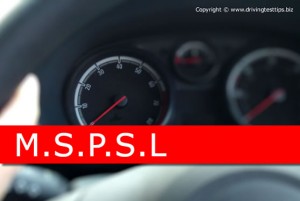MSPSL routine is an abbreviation of the Mirror, Signal, Position, Speed and Look system used by many driving instructors. MSPSL is an extension of the familiar MSM (Mirror, Signal, Manoeuvre) routine.
It uses the basic principles of this technique but extends on this by incorporating correct positioning, speed and look as the manoeuvre. There are various occasions where the MSPSL driving routine is mentioned on the Driving Test Tips site.
For learner driver or experienced driver wishing to take the UK driving test, this section explains when the MSPSL routine should be applied.
MSPSL and driving
During the process of learning to drive, the MSPSL routine should have been explained to you at an early stage. The MSPSL routine is one of the most important aspects that any learner should use. The MSPSL routine should be applied on approaching any junction type, to include roundabouts and crossroads.
It is often applied to other driving situations such as changing lanes and overtaking. During a driving test, the examiner will be expecting you to demonstrate proficiency of the MSPSL routine in a safe, appropriately timed and courteous manner.

Mirror
The appropriate mirrors must be checked on the approach to any junction type. The main interior mirror initially, followed by the door mirror of the direction you are traveling. It’s important to make a note of what you actually see in your mirrors as this ultimately determines the direction you will be traveling regardless of any directions the examiner may have conveyed to you.
For instance, you may be approaching a left turn, you have checked your mirrors and see multiple cyclists to your left, close to your car. If a vehicle is driving extremely close behind you, it may be hazardous to slow down in time to allow the cyclists to pass and to safely make the left turn. It may be safer to continue ahead and not take the left turn. The examiner would find this acceptable. Don’t forget however, it is often necessary in situation such as this to check the car blind spot just after the mirrors.
Signal
The use of signals are to let other vehicles know of your intentions to change direction. Not using signals at all, signalling too early or too late can be dangerous. Signalling too late may not give other vehicles enough time to react to your change of direction, signalling too early may give the impression you are parking up or taking a turn earlier than you actually intend on doing. Signals must be applied approaching left or right turns, T-junctions, roundabouts and changing lanes.
Position
The correct road position must be applied depending on the direction you are taking, the width of the road and if lanes are used. Correct road positioning can be found in the left and right turns, and junctions tutorials. Left turns are usually taken in your normal driving position. Taking the turn too close to the left side of the road may result in hitting the curb as you turn. If making a right turn, position the car just to the left of the centre line in the road.
Speed
Speed is relevant to the location and situation. The location may be a residential street with a closed junction, this may require a much slower speed that a wide open road with open junctions. The junctions tutorial explains the differences between open and closed junctions.
Look
Looking refers to all round observation. Before making a turn, it is important that there are no other vehicles moving into your path, cyclists or pedestrians. Turning left often requires a final look into the left door mirror before making the turn to establish the area is clear of cyclists.
With plenty of practice, the MSPSL driving routine will become second nature. It is important to ensure this is always performed not only for safety reasons, missing a simple but crucial observation or mirror check during a driving test can easily result in a failure.
OTHER DRIVING ROUTINES USED FOR LEARNING TO DRIVE
- Driving routines
- DSSSM – Doors, Seats, Steering, Seat Belt and Mirrors
- MSM – Mirror Signal Manoeuvre
- SCALP – Safe, Convenient, and Legal Position
- POM – Prepare, Observe and Move
- LADA – Look, Assess, Decide and Act

I will like to have more knowledge on driving and road traffic usage. Thanks
If there is a lane marked straight ahead, and an inside lane which accesses two roads going left. Does that lane count as straight ahead for the less extreme left turn? ie do you have to signal left for that, as well as the more extreme L turn.
Also can you turn onto the less extreme L turn when the traffic lights indicate straight ahead – before it indicates L turn. That would clear any traffic behind you who wish to take the more extreme turn
My feeling is that that lane has become dedicated to all traffic as a straight ahead/L turn lane, converting the less extreme L turn into a straight ahead lane, similar to a main road swinging right or left and maintaining the right of way
Hi David,
I’m having trouble trying to picture what you are describing and as such, I don’t really want to comment in case I give you the wrong information. All I would say is that when you’re in a dedicated lane, you do not have to indicate at all unless you intend to take an alternative route out of that lane. Additionally, you’re free to change lanes whenever you wish (ensure you use MSPSL) providing that it’s legal and safe to do so. If the lanes are divided by solid white lines for example, you cannot cross or straddle them except in an emergency.